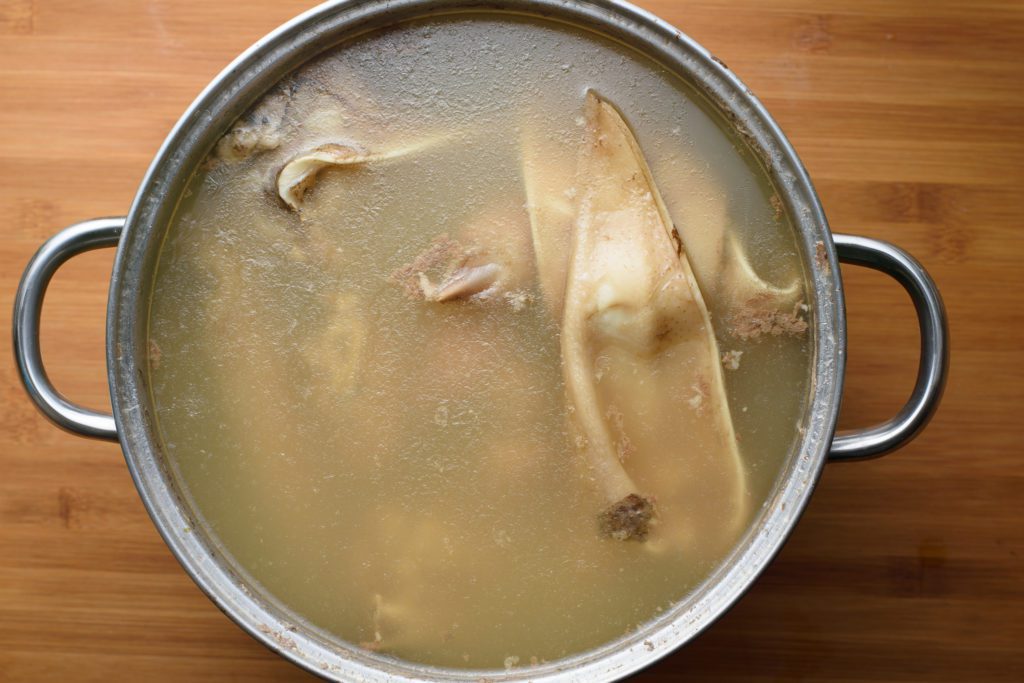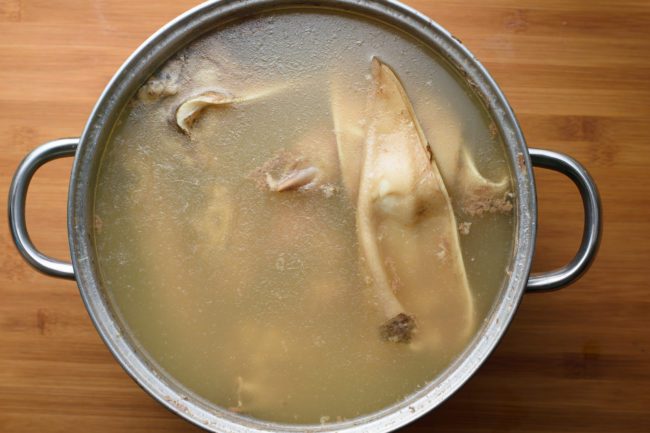Run out of pills or just into the natural way? Check out this Aspic – meat jelly recipe that’s tasty collagen!

Everybody loves jelly in one form or the other. Nowadays though, it seems that the other form is way more popular than the traditional one.
Gummy bears or any other form of sweet jellies are so far from reality that it could be shocking to learn that those little sweet treats are made of pork. The natural collagen found in pork tissues is the secret ingredient in many of sweet childhood memories.
Who would have thought that the skin of a pork could be so appealing? Well, whoever had the “luck” to butcher a pork in their own backyard may have some ideas about salted pork skin or ears but the rest of us have to be content with the vague description of it.
Plenty of us would be happy enough with or even without such tales, though. Reality has the tendency to ruin such beautiful moments. At the end the last thing we want to know when sharing special moments of joy with someone that we are actually chewing on sugared pork skin.
Not only pork skin contains collagen, luckily. Not as a piece of pork skin doesn’t shine through the day when cooked in with some beans in a soup but on its own it’s pretty meager of a dinner.
Joints and ligaments are a great source of collagen too, hence pork feet and knuckles are not only a choice on their own in stew or roasted but could be used in our homemade meat jelly, as well.
Sure enough, if we prefer an aspic a bit more on the meaty side, we don’t need to be frugal about it. The head of the pork is such a piece of cut that suits for such endeavors perfectly being both meaty and gelatin rich.
During the heydays of gelatin when aspic making was raised from the gutters into the high tower of culinary perfection, aspic was made in many forms and incorporated in many dishes. True enough, mainly as a decoration element showing off chef’s skill creating perfectly clear aspic with elaborate forms and imaginary.
Not everybody is a MasterChef nor paid by the food industry to use up their leavings as such was the case when butchering pork got industrialized. When people were offered to buy meat fairly cheaply thanks to decades of optimization in the food production chains, they concentrated their buying power on selected cuts and left others piling up on the abattoirs shop floor.
To address the day by day growing problem, food industry set out to find a solution and possibly make some money on the process. This is how the 50’s got bombed with aspic adverts and recipes in all the places where housewives were found in abundance.
Also, this was the time when gummy bears raised to world fame that is still holding out for today.
Unfortunately, aspic wasn’t so lucky. Its popularity waned, due to consumer preferences shifted that most probably hasn’t got anything to do with food industry’s marketing dollars spent elsewhere.
So it fell on us, the selected few who are clinging to childhood memories through flavors and textures to pass on the memories of aspic to generations to come. The journey is not without its perils and no peace comes without compromises but not all is lost luckily.
With various low carb or natural health conscious diets on the rise there is hope, however faint, for the aspic to raise again.

Ingredients
- 1.5 lbs / 600g Pork knuckle (smoked is even better)
- 1.1 lbs / 500g Pork ear
- 1.5 lbs / 600g Pork feet
- 17 cups / 4000g Water
- 2 pieces / 0.7g Bay leaf
- 1 ½ / 200g Onion
- 2 pieces / 200g Carrots (sliced)
- 1 teaspoon / 0.5g Black pepper
- ½ head / 18g Garlic
- 4 teaspoons / 20g Salt (adjust according to taste)
How to make aspic
- Make sure everything is cleaned and possibly hairless. We won’t have any problems with a bit of extra hair but not many like to see it on their plate. If pork knuckle hasn’t come halved then cut them into halves along the long side. Place all the ingredients, except the salt into a big saucepan.

- Fill the saucepan up with water and bring it to boil. Some like to discard the first boil of water. In this case the spices and herb shouldn’t be added with the first batch of water but only with the second one.

- When water reaches boiling temperature and the bubbles start to appear on the surface of the water, lower the heat.

- Let it simmer for about 3 – 4 hours. When the meat easily comes off the bones it should be ready.

- Salt to taste and let it cool off a little bit. Separate the liquid from the rest of the ingredients. A sieve will come handy at that but fishing out the bits is also an option for those who aren’t in a hurry.

- For a boneless aspic experience remove the bones from the meat. It should be fairly easy but very much greasy. Distribute the meat into the plates, bowls, cups or anything we’ve got at hand. A gallon of stock is pretty big batch considering that half of the volume is occupied by the meat.

- Fill up the plates, bowls, cups with the soon to be aspic. Optimally the whole distribution process should be done where the jelly will set. Otherwise we have to move them one by one to a cool dog, cat, pet or any animal free place. Cover the plates with another one, turned upside down if in doubt. A fridge will be perfect if it is enough place there.

- Let it set for about 6 hours depending on the temperature. The cooler the room is the sooner it will set. Some fat may accumulates on top that can be scraped off if not desired and used up for later cooking. In the fridge, it can be kept for about a week but it can survive a couple of days at 68°F / 20°C. When it starts to liquefy again on its own with no apparent reason (e.g. heat), it shouldn’t be consumed. Not like anyone could do it with a living taste bud.


Enjoy!


Star this recipe!
Aspic Recipe – Meat jelly
Ingredients
- 1.5 lbs Pork knuckle smoked is even better
- 1.1 lbs Pork ear
- 1.5 lbs Pork feet
- 17 cups Water
- 2 piece Bay leaf
- 1 ½ piece Onion
- 2 piece Carrot sliced
- 1 teaspoon Black pepper
- ½ head Garlic
- 4 teaspoon Salt
Instructions
- Make sure everything is cleaned and possibly hairless. We won't have any problems with a bit of extra hair but not many like to see it on their plate. If pork knuckle hasn't come halved then cut them into halves along the long side. Place all the ingredients, except the salt into a big saucepan.

- Fill the saucepan up with water and bring it to boil. Some like to discard the first boil of water. In this case the spices and herb shouldn’t be added with the first batch of water but only with the second one.

- When water reaches boiling temperature and the bubbles start to appear on the surface of the water, lower the heat.

- Let it simmer for about 3 – 4 hours. When the meat easily comes off the bones it should be ready.

- Salt to taste and let it cool off a little bit. Separate the liquid from the rest of the ingredients. A sieve will come handy at that but fishing out the bits is also an option for those who aren't in a hurry.

- For a boneless aspic experience remove the bones from the meat. It should be fairly easy but very much greasy. Distribute the meat into the plates, bowls, cups or anything we've got at hand. A gallon of stock is pretty big batch considering that half of the volume is occupied by the meat.

- Fill up the plates, bowls, cups with the soon to be aspic. Optimally the whole distribution process should be done where the jelly will set. Otherwise we have to move them one by one to a cool, dog, cat, pet or any animal free place. Cover the plates with another one, turned upside down if in doubt. A fridge will be perfect if it is enough place there.

- Let it set for about 6 hours depending on the temperature. The cooler the room is the sooner it will set. Some fat may accumulates on top that can be scraped off if not desired and used up for later cookings. In the fridge, it can be kept for about a week but it can survive a couple of days at 68°F / 20°C. When it starts to liquefy again on its own with no apparent reason (e.g. heat), it shouldn't be consumed. Not like anyone could with a living taste bud.

Notes
Nutrition
Pin now, Enjoy later!


















Tasty!
Good looking one!
It is indeed!
It it knows it!
finally, a low crab meal that is as delicious as it is beautiful.
You speak from my heart. Yet I can’t decide if there is sarcasm between the lines 🙂